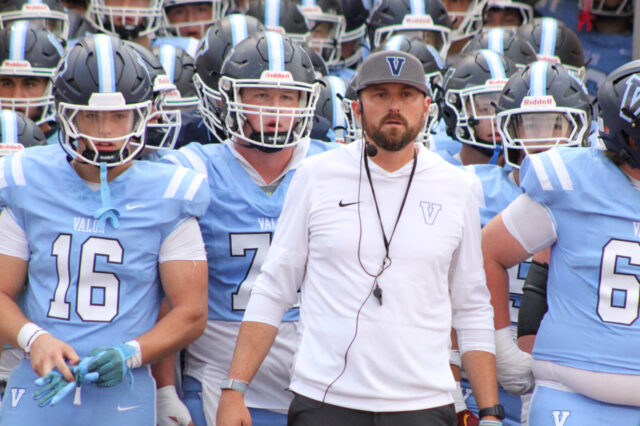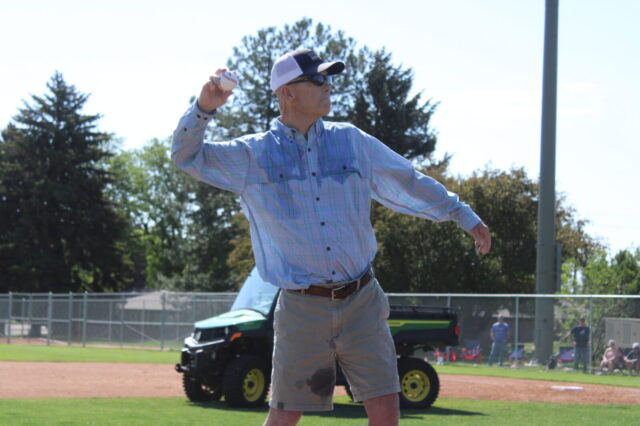This article originally appeared in Mile High Sports Magazine. Read the full digital edition.
“Victory is won not in miles but in inches. Win a little now, hold your ground, and later, win a little more.” – Louis L’Amour (1908-1988), writer and a summer resident in Durango, circa 1966-76
The truest competitors are those without excuses.
They know that losers having nothing more to say than “Nice game” to the victors.
The weather, the refs, the bad bounces, the injuries and whatever else the Fates may throw at them – even if they strongly influenced the outcome – are never referenced, never acknowledged.
Get on the bus; go home. Report to practice tomorrow.
Durango High School, home of the Demons, located some 335 miles from Denver in the far southwest corner of the state, is a school full of competitors who know how to board a bus. The town of Durango, formed by the Denver and Rio Grande Railroad Company along the banks of the Animas River in 1880 – eight years after gold fever struck the area – to serve the San Juan mining district, is teeming with competitors who attack the trails, the mountains, the ski runs and the whitewater just as they used to attack the gold and silver.
In mid-January, I had some business in Durango, to which I haven’t traveled for at least five years, and thought that Colorado’s 33rd largest (16,887 competitors) but often forgotten city would be a good feature for this space’s “Only in Colorado” series. If not for the pressing nature of my business, I might have chosen the spring or summer for the six and half hour journey (under ideal conditions) but, after all, winter travel in southern and western Colorado is part of the Centennial State experience.
And so I packed up the 1996 Volvo 850 POS and headed out of southeast Denver at 6 a.m. on a nippy Friday morning. The old Swede had just turned over 200,000 miles and had been running like a dreidel. But somehow she must have sensed the arduous nature of the impending journey and within the first five minutes out of the driveway stalled twice on Hampden. Having no desire to be stranded on top of Wolf Creek Pass in mid-January, I returned home and repacked my gear in Barney, a 2014 kite blue Mini Clubman – 120 horsepower, automatic, all-season tires, barn doors in the rear – and set off again.
I had a 3:30 p.m. appointment with Durango High School athletic director Dave Preszler and had told him I wanted to talk about the challenges of running an athletic program for 1,066 students (70 percent of whom participate in some sport or activity) from such a remote outpost as Durango.
In my experience, the city folk from Colorado Springs to Fort Collins generally disregard the schools from Western Colorado. It’s not that they think they’re bad people, it’s just that they see no need to associate with them when they have hundreds of competitive schools their own size within a 15-mile radius.
The Class 5A schools from Grand Junction (Junction, Junction Central and Fruita Monument), for example, routinely bus their teams 245 miles across I-70 to Denver for early season tournaments and meets so they can foreshadow some of their potential state tournament competition. Very few Front Range schools return the favor, leading to the common Western Slope refrain, “The road doesn’t go both ways.”
Thus, I was anticipating some general griping from Preszler, in his second year as the Durango athletic director but a veteran Western Sloper by way of North Dakota and Montana. He spent eight years as an administrator at nearby Bayfield High School after 14 years as the AD at Fort Lewis College – originally an Indian School, located on the Ute Reservation – where he also served as the Skyhawks’ head football coach for two years.
But Preszler refused to take the bait when I asked him about travel and his dealings with the state’s prep governing body, the Colorado High School Activities Association. “There might have been a perception at one time that Durango was far enough away that they couldn’t hear us yell,” he said, “but they hear us now.”
While it might sound crazy to some that Durango’s Class 3A South Central football conference (they’re 4A in most other sports) next year is composed of Colorado Springs schools Harrison and Sierra (about six hours away) and Pueblo schools Central, County and East (over five hours away), Preszler appreciates the fact that half his schedule is already set for 2016, and it will include some home games.
“Dave has been very involved in the process and his input has been valuable,” notes CHSAA assistant commissioner Harry Waterman, who is responsible for the football format in all seven classifications (don’t forget 6-man and 8-man).
Of course, Durango’s transportation – usually by school bus, sometimes by a 15-passenger minibus driven by the team’s coach – challenges are multiplied in the winter when school district policy forbids travel over the notorious Red Mountain Pass. Depending on the severity of the weather, there are three routes to Grand Junction, where much of their competition resides:
Red Mountain: Durango-Silverton-Ouray-Montrose-Delta-Junction…
Lizard Head: Durango-Mancos-Dolores-Telluride-Ouray-Montrose-Delta-Junction …
Moab: Durango-Mancos-Dolores-Dove Creek-Monticello-Moab-I-70-Junction…
When I asked Preszler how many miles each of the routes were, he said, “We don’t talk mileage in Durango; we talk hours, as in 4:30, 5:15 and 5:30.”
Any way you look at it, Durango athletes and coaches put in a lot of seat time in the course of a season during which they’ll enjoy Colorful Colorado, the Beehive State and the Land of Enchantment, where Demon teams regularly schedule similarly sized schools in Farmington, Aztec, Bloomfield and Shiprock.
Coach Alan Batsiste’s varsity boys basketball squad, for example, will clock over 25 hours and 1,400 miles during the 2015-16 season, and that’s before playoffs begin and the opportunity for some really long travel presents itself. Batiste, a Tucson native who was an All-RMAC second-teamer at Ft. Lewis under legendary coach Bob Hofman, is in his sixth year as the Demons’ head coach. If the long bus rides tend to make his players sluggish they wake up in a hurry playing the run-and-gun style he learned from Hofman, who won 572 games in 40 seasons as a high school and college head coach, including the 1981 4A state title at Fairview High School. Hofman played point guard at CU under Russell “Sox” Walseth from 1970 to 1974, then was a Buff assistant coach from 1981 to 1983 for Bill Blair and Tom Apke.
Ann Duft, Durango’s athletic administrative assistant, echoes her boss’ sentiments about the school’s remote locale and the travel it engenders. Her daughter Kathleen, a junior swing player on the volleyball team, doesn’t complain about long bus rides.
“She’s never known anything different and just accepts it,” says Duft. “She does a lot of studying on the bus.” It’s not unusual for Ann and her husband to get up at five o’clock on a Saturday morning and drive five hours to see their daughter play a match in Grand Junction. The coaches and athletes aren’t the only dedicated ones in Durango.
One of the best bus rides of the year for a Durango team so far – particularly the one back home – was the trip the boys cross country team took to the Norris Penrose Events Center in Colorado Springs last fall. Led by Benjamin Lachelt’s fifth place finish and David Moening’s tenth, the Demon harriers of coach David McMillan captured the school’s first team state title since 1999 and its seventh boys cross country state crown.
The town of Hartsel (served by South Park High School) is the geographic center of Colorado. Cherry Creek High School is the largest school in the largest metro area of our state. Durango High, while closer to more schools in New Mexico than Colorado and way more than a loud holler from Denver, is every much a part of Colorado’s high school athletic scene as South Park and Creek. As they have since 1893, Durango Demon athletes will continue to get on the bus and compete without excuses.



